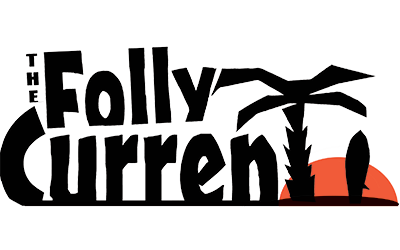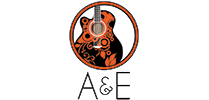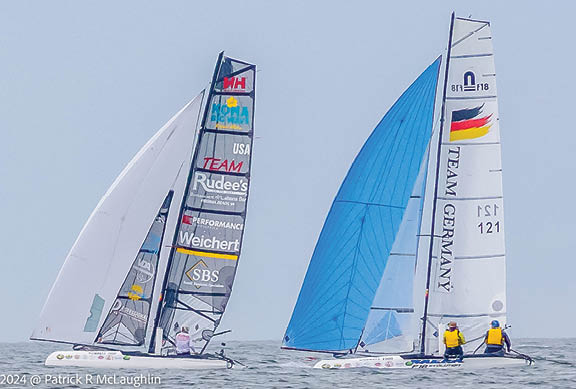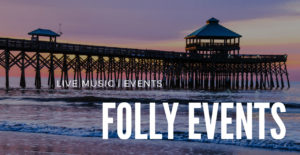Folly Beach offers a brief respite for competitive sailors on 50th birthday of the Worrell 1000
by Jenny Peterson | Current Staff Writer
For a dozen two-man catamaran teams who competed in a grueling 1,000-mile nautical journey up the East Coast from Florida to Virginia, Folly Beach was a welcome respite.
Every other year, The Worrell 1000 Race, an offshore long-distance beach catamaran sailboat race, runs in the waters between Florida and Virginia Beach that takes roughly two weeks and draws competitors from around the world.
Folly Beach was a checkpoint stop for the weary sailors, and a dozen 18-foot catamarans came ashore at the Folly Beach County Park on Friday, May 17.
Ground teams for each boat were waiting to help guide the boats onto the sand, check in with the men on board and make any needed repairs before the next leg of the journey.
Folly Beach was designated as The Worrell 1000 Race’s only “lay day” this year with extended rest and relaxation. Sailors and their teams booked rooms at the Tides Hotel and were given a full 24 hours to relax before casting off promptly at 10 a.m. on Sunday, May 19 heading towards the finish line in Virginia.
While visiting Folly Beach, the teams were treated to a Lowcountry boil by the Folly’s Tourism Visitors Promotion Committee at the Dunes House at the Folly Beach County Park.
The Tides also held a media day for the sailors to answer questions and share their experiences. The race was featured in many regional news publications.
“We had never taken the ‘lay day’ before to talk with the teams and bring their stories to the world,” said John Williams, the Worrell 1000 principal race officer and former championship sailor with the Pan American team.
Humble Beginnings
The Worrell 1000 Race dates back to 1974, when two brothers casually bet each other at a bar that they could outsail the other in an ocean race from Virginia Beach to Florida. Only one brother completed the journey—following 20 days at sea with just one friend/crew member for support.
“(The other brother’s) boat fell apart under him in Fort Lauderdale,” said Williams. “The race got so much attention they thought, ‘we might be on to something.’”
The brothers’ bar bet started a tradition in the catamaran sailing community with this one-of-a-kind race sailing up the Eastern seaboard of the United States. The Worrell1000 Race is now a non-profit organization which raises money to support the teams and plan the races.
Celebrating 50 years this year, The Worrell 1000 Race follows the same course the brothers bet and draws sailors from around the world, including this year two teams from Australia, Germany and France. Many teams sign up years in advance. The races uses specific Formula 18 class double-hulled catamarans with a trampoline netting in the middle.
“There are very specific measurements—boats can only be 18 feet long and 8.5 feet wide. There are limits on the mast height and the sail area so everybody’s racing equally,” Williams said.
Sponsors support teams and boat manufacturers have even taken the opportunity to showcase different catamaran designs and test their limits specifically for the race.
“Different manufacturers can add some design elements that gives their boat a slight advantage. Some boats (in the race) this year were new out of the box and others have been tested in previous events,” Williams said.
This year, sailors from the Netherlands, Germany, Great Britain, South Africa, and France, and several teams from the United States, including California, Florida, and Virginia Beach, competed. One participant, Randy Smyth, sailing for his sponsor Team Rudees out of Virginia Beach, had won the race six times before and has been participating since 1985, Williams said.
Williams explains that the race is an incredible test of strength and fortitude both physically and mentally. Boats sail rain or shine and it’s common for catamarans to start the race in Florida and not finish due to unfavorable weather conditions.
“In our 50-year history, only four times have all teams that started made it to the finish line,” Williams said.
This year’s race had 15 boats start in Florida; only 12 made it to the finish line in Virginia, Williams said. One team had to abandon their boat off Cape Canaveral following tough weather this year.
“There’s been many times when hundreds of hours of preparation and preparing go in, and your boat comes floating back to the beach in pieces,” Williams said. “Back in the early 2000s, the surf was so huge that boats flipped and broke in the surf. As a sailor, you’re left scrambling. The well-financed teams will have a backup boat completely rigged and ready to go. Other teams will spend all night trying to put their boat back together so that they can stay in the race.”
The shortest leg of the race is the last one into the finish line in Virginia Beach, about 55 miles. The longest leg is 120 miles between Jacksonville, Florida and Tybee Island, Georgia.
The Worrell 1000 Race started initially as a 24/7 continuous night format, but checkpoints were added over the years to garner more interest with the public and to help with repairs. There are 13 total checkpoints now.
This is the second time Folly Beach was chosen as a checkpoint. Williams said the draw was due to Folly’s large beach and the availability of the Tides hotel to accommodate the teams and their crew.
“It’s a beautiful beach and it’s a killer stop,” Williams said. “Folly has such a great vibe. All of us are ‘beach people’ and it’s just a really comfortable place.”
Carl Hally, a board member of Folly’s Tourism Visitors Promotion Committee, said the committee was approached by the Worrell 1000 race committee about being a checkpoint and jumped at the chance to show off Folly to the sailors and supporters from around the world.
“It’s a real plus for Folly to attract international attention,” Hally said.
Taking first place overall for the 2024 race was Australia 1, who completed the 1,000-mile race in 90 hours, nine minutes and 11 seconds. Brett Burvill was the skipper and Max Puttman was the crew, both first-time competitors in the Worrell 1000 Race and both boat manufacturers in Australia, Williams said.
“Brett designed and built the boat and Max designed and built the sails. They really had a dominant performance,” Williams said.
The committee is already planning the May 2026 race—Williams said it takes too much preparation to hold the race every year—and the race committee is already reviewing resumes for teams to prove their competency for such a challenging course.
“It’s not a ‘weekend warrior’ race by any stretch,” Williams said. “The Worrell 1000 Race is Everest. This is the Super Bowl. This is the Tour de France. There is nothing harder in (racing) beach catamarans anywhere in the world. Nowhere else has a race across such challenging water. We round three major capes—Cape Canaveral, Cape Lookout, and Cape Hatteras. If you can say that you started and you finished, it’s a major accomplishment. Folks in the beach catamaran community know exactly what that means.”
The race committee is expanding its social media reach to garner more interest; Williams said there were more than 1 million views of the various videos posted on the group’s Facebook page, including a video of the catamarans coming ashore on Folly Beach.
Williams said he hopes that checkpoints like Folly Beach, along with a concerted effort to document the race on social media, will bring renewed interest to the race and the challenging course.
“There’s nothing like ripping along doing 18 knots faster than a power boat in full moonlight along the coast of South Carolina. This year, we got a full moon in South Carolina. It was silvery and gorgeous and you’re just flying along. There’s lots of sea life; I heard somebody say they saw a whale, lots of dolphins, and lots of sea turtles. There was some bioluminescence on the Florida legs. The boats are spread out by a couple of miles pretty quickly as everybody tries to pick their strategic line and you’re essentially alone in the ocean. It’s beautiful.”
While this year saw only male teams compete, Williams said he hopes women teams join in the future.
“We’ve had several women compete in the past. At the awards ceremony, there were two or three daughters (of sailors) that were following along with their dads’ campaigns and we hope that a couple of them throw their hat in the ring in the future,” Williams said.
As for a stop on Folly in 2026? Williams said the race committee would be happy to have Folly Beach once again provide a respite for the hard-worn sailors.
“With the level of support that we’ve gotten from Folly, we absolutely want to stop there again,” Williams said.
Follow along at www.worrell1000race.com and www.facebook.com/Worrell1000.














